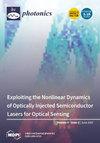余弦剖面中一维和二维非衍射模式的精彩解读
IF 2.1
4区 物理与天体物理
Q2 OPTICS
引用次数: 0
摘要
我们基于射线光学和狄拉克符号,对余弦剖面中的 1D(一维)和 2D(二维)非衍射模式(通常称为余弦光束)进行了简单分析。我们探讨了由两个一维余弦光束叠加形成的各种结构模式。然后,我们继续从余弦波束的角度来理解贝塞尔波束的特性。我们首次报道了基于一维余弦光束干涉产生的三维可调针状结构。这些尺寸可调的光针在材料加工方面具有多种优势。此外,我们还首次报告了余弦光束中的塔尔博特效应。通过简单的数学计算,我们得出了余弦光束的分析表达式。目前展示余弦光束的方法可用于理解其他结构模式。这里使用的基于狄拉克符号的干涉解释可以为新研究人员提供一种简便的方法,让他们在干涉实验的基础方面以及光束工程技术、成像、粒子操纵、光片显微镜和光物质相互作用等高级实验中理解光的波性质。我们还深入分析了余弦光束、贝塞尔光束和赫米特-高斯光束之间的相似性。本文章由计算机程序翻译,如有差异,请以英文原文为准。
An Intriguing Interpretation of 1D and 2D Non-Diffracting Modes in Cosine Profile
We provide a simple analysis based on ray optics and Dirac notation for 1D (one-dimensional) and 2D (two-dimensional) non-diffracting modes in the cosine profile, which are often called Cosine beams. We explore various kinds of structured modes formed by the superposition of two 1D Cosine beams. We then went on to understand the properties of the Bessel beams in terms of Cosine beams. For the first time, we report on the generation of three-dimensional tunable needle structures based on the interference of 1D Cosine beams. These size-tunable optical needles can have multiple advantages in material processing. Also, we report, for the first time, on the Talbot effect in Cosine beams. Straightforward mathematical calculations are used to derive analytical expressions for Cosine beams. The present method of demonstrating Cosine beams may be utilized to understand other structured modes. The Dirac notation-based interference explanation used here can provide new researchers with an easy way to understand the wave nature of light in a fundamental aspect of interferometric experiments as well as in advanced-level experiments such as beam engineering technology, imaging, particle manipulation, light sheet microscopy, and light–matter interaction. We also provide an in-depth analysis of similarities among Cosine, Bessel, and Hermite–Gaussian beams.
求助全文
通过发布文献求助,成功后即可免费获取论文全文。
去求助
来源期刊

Photonics
Physics and Astronomy-Instrumentation
CiteScore
2.60
自引率
20.80%
发文量
817
审稿时长
8 weeks
期刊介绍:
Photonics (ISSN 2304-6732) aims at a fast turn around time for peer-reviewing manuscripts and producing accepted articles. The online-only and open access nature of the journal will allow for a speedy and wide circulation of your research as well as review articles. We aim at establishing Photonics as a leading venue for publishing high impact fundamental research but also applications of optics and photonics. The journal particularly welcomes both theoretical (simulation) and experimental research. Our aim is to encourage scientists to publish their experimental and theoretical results in as much detail as possible. There is no restriction on the length of the papers. The full experimental details must be provided so that the results can be reproduced. Electronic files and software regarding the full details of the calculation and experimental procedure, if unable to be published in a normal way, can be deposited as supplementary material.
 求助内容:
求助内容: 应助结果提醒方式:
应助结果提醒方式:


